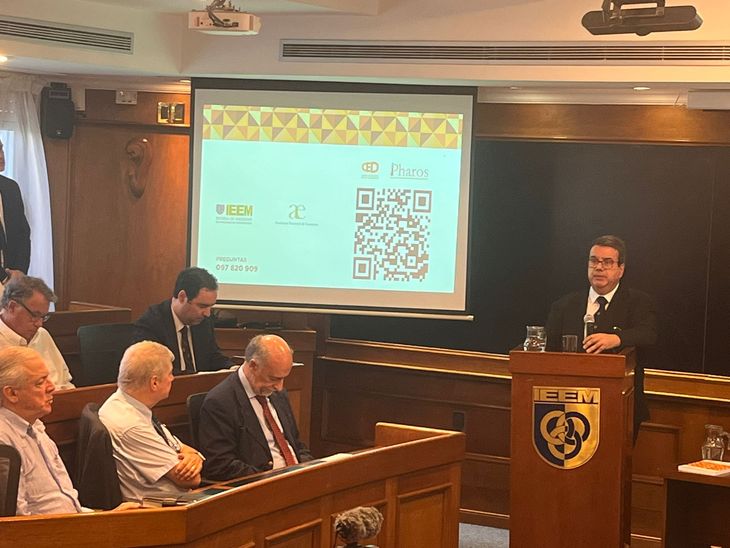The National Academy of Economics presented a project that proposes regulatory changes on the working market in Uruguay as flexibility of schedules, analysis of productivity and competencies, whose final objective is to propose solutions that are then taken to the Parliament.
The academic publication is named “More and Better Work” and compiles proposals for changes in labor regulations on the labor market. It also contains elements such as the size of the companies as one of the starting points.
The initiative is led by the Academy of Economics and its think tank Pharos, next to the Center for Development Studies (CED), and supported by research carried out by professors from the business school of the University of Montevideo.
Leonardo Veiga, professor of political economy at the University of Montevideo and member of the team at the Business School of this university, which carried out this research together with Valeria Fratocchi, Sofía Harguindeguy and Santiago Madalena, reported that this is a project that has been going on for two years, promoted by the Academy through Pharos, which aims to identify the obstacles faced by labor regulations in Uruguay and generate solution proposals.
WhatsApp Image 2024-03-07 at 17.45.26 (1).jpeg
The size of the companies
“The size of the companies is one of the most important issues to consider. The same work arrangement does not have the same impact on large companies as small and medium-sized ones. And it is precisely the small and medium-sized companies that are the great generators of employment”, Veiga said to Ambit.
And he added: “One of the problems that arises is that the diversity of companies that are covered by each Salary Council It is very diverse and growing in diversity. Therefore, the same resolution of a Wage Council does not have the same impact on one company as on another. We have to try to see how the way of working changes, in a way of respecting that diversity.”
The project proposes changes in the rules regarding working hours, in the form of intermediate breaks, in the way in which the licenses, in the way in which the sectors of activity in the Salary Councils.
Furthermore, it is proposed to move from task-based categories to competency-based categories, rules regarding how a company can be removed from a board, moving to automatic removal mechanisms under the analysis of the cost structure, among other items.
It is proposed that if the worker and the employer agree on a regime of 40 hours per week, In principle, the worker and the employer can define that those hours are going to be distributed in a non-homogeneous way, making the format in which they are fulfilled more flexible.
WhatsApp Image 2024-03-07 at 17.45.27.jpeg

Productivity is another of the issues raised
Starting from the debate on the definition, examples are used that explain the diversity of the concept. “For example, a salesperson is paid for productivity. He has a fixed amount, but in essence, the bulk of his income is based on what he is selling,” Veiga said.
In this regard, he indicated: “And what the businessmen said is that in order for there to be payment for productivity Two fundamental conditions must be met. The first is that, and this was thus a demand of the company, it is, I resort to payment for productivity when I cannot control what the worker does.”
“In other words, I have to pay a salesperson for productivity because there is no point in being above him to sell more. He has to arise spontaneously. Now, someone who is on an assembly line and has to tighten a nut, the pace of work He doesn’t define it. So, I don’t need to make a productivity payment to make sure that his work is well done,” Veiga added.
Along these lines, he noted: “Businessmen say, very well, I suppose we would establish a payment system for productivity. When productivity increases, it is assumed that pay would increase. And when productivity goes down, do your income go down? salaries?”
The report, which also contains a survey directed at employers, states that 33% are very aligned with the salary guidelines established by the Executive power, but when it refers to micro, small and medium-sized companies, the percentage is 14%.
When asked about involvement in establishing these guidelines, in the case of large companies it is around 50%, but among SMEs becomes almost zero.
Mieres’ assessment
He Minister of Labor and Social Security, Pablo Mieres, He considered the work valuable and added that “there is an academic, deep, serious, rigorous and exhaustive reflection, but then there is a concrete landing, looking at what should be possible up to drafting of draft laws and specific topics that are linked to what From the perspective of those who carried out this work, they imply improvements to generate more and better work in our country.”
“The great virtue of this work is that it puts the issue on the table without fear, that it incorporates a wide variety of topics and also presents very specific short, medium and long-term proposals. It is interesting because this reflection is also presented in a context that is one of frank recovery of the employment, with significantly better indicators than those we had in previous years, even in the years before the pandemic,” said Mieres.
Source: Ambito




